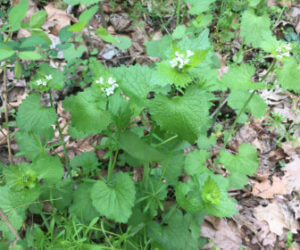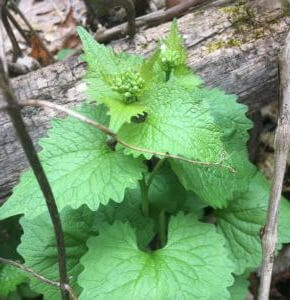Make a Foraged, Immune-Boosting Pesto for Spring
Spring is just around the corner, and foragers are dusting off their baskets and clippers and setting out to find what treasures mother nature has to offer. If you’re looking to start foraging but need a simple place to begin, try finding and cooking with garlic mustard! Not only is it relatively easy to find, but it’s also an invasive species, so by harvesting it you’re doing the environment a favor, too.
The following is by Sarah Bir, author of The Fruit Forager’s Companion. It has been adapted for the web.
(Heading photo credit: Phil Moore. All other photos courtesy of Sarah Bir unless otherwise noted.)
Foraging is about what’s abundant right now. Where I am (and very likely you are), right now is spring, and that thing is garlic mustard. I’ve been relying on this wily weed to jazz up soups, scrambled eggs, and pastas. Think of it as a cross between a cooking green and an herb.

Garlic mustard (Alliaria petiolate) is invasive in North America, where it thrives in temperate woodlands and meadows. Its tenacity is such that it sends out toxins to make nearby soil inhospitable to native plants. So you can, and should, harvest it with aplomb. Grab right down at its base and yank it up by the root.
A member of the mustard family, it resembles mustard greens in flavor, but with—yes—a wisp of garlic in there, and a large dose of bitterness. I like the still-closed flower buds, which resemble broccoli rabe in appearance and taste. I’ve been relying on this wily weed to jazz up soups, scrambled eggs, and pastas. Think of it as a cross between a cooking green and an herb.
That bitterness indicates a dynamite nutritional profile, but it can overwhelm. I like to taste the leaves raw before I harvest. Cooking seems to increase, not decrease, that bitterness, so I add leaves and buds at the finish of cooking. The stems I don’t bother with. Any part of this pant you’re not cooking should go in the garbage, and not the compost. You don’t want to aid in spreading it.
My favorite use for gobs and gobs of garlic mustard is this pesto.
Garlic Mustard Pesto
Makes about 1 cup
Garlic mustard is grassy and feral, but that’s what makes it interesting. It will remind you of the woods where you found it. This pesto has a forceful flavor, and is best paired with likewise robustly flavored foods. Try it on pasta with a strong parmesan and some capers that have been quickly fried in olive oil. Float a big dab on minestrone. Smear it on meats after grilling or roasting them. It’s also nice on oily fish like trout or salmon.

Ingredients
- 8 cups loosely packed garlic mustard leaves and buds, stemmed (about 90 grams)*
- 2 garlic cloves, smashed
- 1/2 cup (43 grams) pine nuts or hulled hemp seeds
- 1/2 teaspoon kosher salt, plus more if needed
- 1 teaspoon lemon juice
- 1/3 to 1/2 cup extra-virgin olive oil
Procedure
- Put the greens, garlic, nuts or hemp seeds, salt, and lemon juice in the bowl of a food processor fitted with a steel blade.
- Pulse a few times to break up the greens and decrease the volume. Then, with the machine running, add the olive oil in a thin stream and process until a smooth paste forms.
- Taste and adjust seasoning as you wish. You want it to be highly seasoned.
If not using all the pesto immediately, transfer to a covered container and refrigerate for up to two weeks. You may also freeze the pesto for up to a year.
